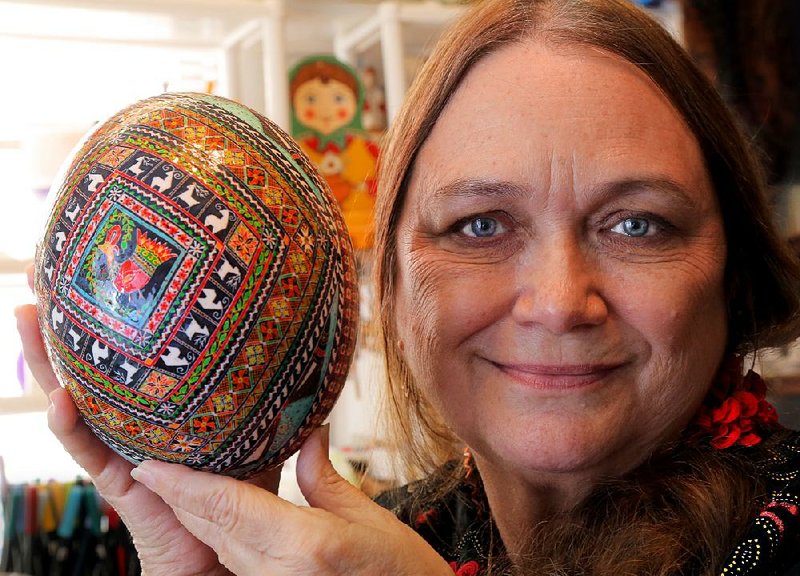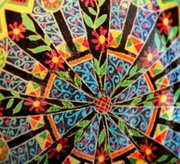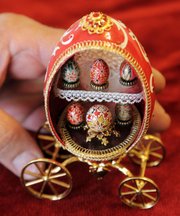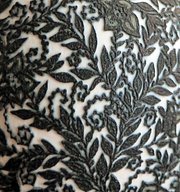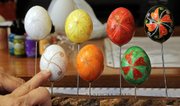HOT SPRINGS -- No way the item in Lorrie Popow's palm is a real egg. No way.
Egg is too simple a word. Try "ovoid." Maybe "bedizened" ovoid. And no way its intricate, interlocking decorations aren't decals or painted on.
They were washed on in layers? Using dye?
Even Popow finds this amazing. "Many times as I'm unwrapping my eggs -- and I know they're my eggs -- I'm unwrapping and then" -- a gasp -- "Oh, myyyy."
To see more
Lorrie Popow’s website has her bio, gallery, teaching schedule and a link to the Popows’ photo book. http://pysankymaste…">pysankymaster.com
The Facebook page “Eggs and Things by Lorrie Popow” includes current work. http://www.facebook…">facebook.com/eggsan…
Her YouTube channel includes how-to videos. http://youtube.com/…">youtube.com/user/Lo…
The Facebook page “Incredible Eggs” is a closed group for egg decorators. http://facebook.com…">facebook.com/groups…
Popow, the Arkansas Arts Council's 2015 Arkansas Living Treasure, is the state's only acknowledged master of pysanky -- egg decoration, an ancient Ukrainian craft.
Her eggs do not make the craft look easy. And yet she flatly assures admirers that, truly, they could make these eggs. Not like hers, but give it 50 years. That she can teach them.
"Yeeeah," she says, in a hard-to-place accent. Teaches people every day. She's teaching the entire planet right this very minute, on her YouTube channel.
After a few minutes surrounded by ... one wants to say egg obsession ... in the tidy cottage where she and husband Tom Popow raised three children and nursed two elderly parents, visitors do learn something: That this woman's eggs are more than merely pretty.
Popow clicks open the glass door of a curio cabinet filled with small and gleaming festivals of egg art and confides that she's slowing down. Yeeeah. No more craft shows for her and Tom. Each egg takes longer and longer now. But being named a living treasure is thrilling, and 2015 is also the couple's 50th wedding anniversary.
"I'm having a good time," she says. "You know, life has been a real adventure. It's been a journey, you know, sicknesses, deaths, this and that."
She can't help weeping a little as she shows off her pysanky, which conveys a sense of deep emotion but in fact is more about her nose than her heart. On this cool but humid morning, pollen hovers above the Popows' patch of yard, dusting their narrow street as it bends behind Oaklawn race track, where long-legged horses prance and blow.
It hasn't escaped her notice that Oaklawn is an oval. And there are many dozens of pysanky eggs displayed in the Popows' front room, watched over by a mirror composed of three overlapped ovals.
"I was accused that I was obsessed with them but, no, this is just a passion. This is just a love of them," she says, holding up an intricately floral quail's egg -- a quail's egg, for crying out loud. "Even the plain eggshell. Even the shape! They're just beautiful for me."
For her, these eggs do not carry the ancient Ukrainian significance, which she explains was rooted once upon a time in springtime spiritual rituals:
"Before you even start on the eggs, you go to all your family, all your friends, your neighbors, anyone that through the year you have said a mean word to, you go to them and apologize. So before you start working on that egg you have a clear conscience, clear mind," she says. "And now you can put all these wonderful thoughts in your work.
"And then the eggs are given as gifts."
No, for modern crafters, the meaning of pysanky rests largely in the methods of making, all those layers plotted out and painstakingly applied.
First the egg is emptied, and not by blowing unless you're not afraid of salmonella; people use air compressors or aquarium pumps. Then comes drawing the design on the egg in pencil; then alternating layers of wax and water-borne colorants go on. Layer builds upon layer, deepening darkness, until the maker applies heat to melt away the muddle and reveal defined patterns.
Still, explaining her own eggs leads Lorrie (and Tom, he has to help) inexorably into a story for which they must talk over each other, their voices layering on details. It's about war, chaos, family bonds. These eggs, Tom says, are about being female.
They are also, Lorrie says, beautiful. Like a family, like the bonds built by what looks like a real mess.
OVERLAPPING HISTORIES
Elegant in black and red, standing 5 feet, 1 1/2 inches tall, and with her thick braid and unfamiliar accent, Popow might pass for a Ukrainian grandmother, in these parts. Because how many Arkansans know what Babushka should look or sound like?
And she did grow up in Chicago's ethnic Ukrainian Village.
But no. "I'm Irish and Cherokee, yeah," she says. Her lilting words are pegged with extra D's, D-like T's and soft little exclamation points. Her family fled their native Tennessee; they skipped out on their tribe's whole Trail of Tears experience.
"I'm as American as can be," she says. And her stepfather was Polish.
Ihor "Tom" Popow, is from a Ukrainian family. He was born in 1947 outside Hallendorf, Germany, which had been a Nazi forced labor camp where his family had escaped being gassed or shot thanks to his mother's command of the German language.
The saga of how his father and mother met in that camp and married even though Father was already married and had a wife and two little sons somewhere else in the war zone, and of how Ma figured out what they needed to claim to get themselves sponsored into America and then how Father worked too hard and suffered a stroke, and then moved to Hot Springs, and then how Ma left him for another old man -- this tale is cheerfully told by the Popows in tandem. They jump in and out of each other's sentences.
What happened to Tom's stepbrothers? Dead in the war? Who knows?
But the point here is, as Tom says, he's the one who is Ukrainian. Lorrie's Indian: "So we cross cultures. And this is before we met. I liked Indian things, and she liked Ukrainian."
Tom and Lorrie have been best friends since high school. Did he introduce her to pysanky?
"Oh no, I just liked him," she says. "Yeah," that artwork had nothing to do with this 50-year marriage.
STOPPED IN HER TRACKS
Around Easter in 1956, an often lonely, 8-year-old Laretta Harbin stood stock-still on the sidewalk in front of Delta Ukrainian Enterprise, a gift shop two blocks from her stepfather's home on Chicago Avenue. A woman in the window applied colored slop and wax to a chicken egg until it was dark and ugly.
And then, miracle in a flame, "Color!" Lorrie says, almost clapping.
She asked Ukrainian schoolmates what they used to make such eggs, and they said wax and dyes.
A friendly woman at a small hardware store gave the child some paraffin. And one day while she was washing dishes -- "being the only child, my mom made me do a lot of work" -- her mother was wrapping presents and hollered at Lorrie to get more paper.
At first she thought she'd cut her damp fingers on the crepe paper. But then -- "Dyes! I invented dyes!"
She bought all the crepe paper she could, which was plenty because that stuff was cheap. "Being an only child left at home all the time, I would boil that crepe paper, and when it would cool off I was the most colorful kid you could meet."
But she didn't know that pysanky artists apply wax using a tiny funnel on a stick, called a kistka. She used a toothpick. The results were "mooshy." She gnawed this puzzle off and on for years, even after she and Tom married in 1965 ("He was 18, I was 17"), until the day her mother came home with a book on pysanky.
"She threw it at me. She says, 'Is this what you're looking for?'"
The book explained kistkas, but more importantly, it said to use beeswax, which has a higher melting point than paraffin and won't smear.
Tom, who had been an altar boy, knew where to find beeswax: church candles. And his grandmother made Communion wafers, and visited a lot of churches.
In 1968 he researched kistkas and made Lorrie one from a coat hanger. It blooped the wax, she said, making "the ugliest eggs you can imagine."
It hangs with other flame-blackened kistkas in a shadow box in her studio. She's had an electric kistka on her worktable since 1975.
TWO ARTISTS, ONE HOUSE
When Popow stands below the triple-oval mirror and says, "This is me, this is my eggs," she's also gesturing to Tom Popow's home and studio. His works share the walls and dominate their own display shelves.
He's a flint-knapper. He creates by chipping away the part he doesn't want.
Lorrie creates by adding. "Yes, I'm a plus. I'm a plus!" she says, delighted.
"And I'm the one that's Ukrainian, and she's the one that's Indian," Tom says.
The couple have self-published a photo book, Eggs by Lorrie, Arrowheads by Tom.
Lorrie's studio once was a child's bedroom. She has packed it to the ceiling with white plastic shelves and translucent plastic boxes full of tissue paper, ribbons, needles, fingernail-staining dyes in small bottles, and eggs and eggs and eggs and eggs. Faint colored drips stain the wood floor.
"I'm creating dust in this room, she's creating dust in her room," Tom says, leading the way to his studio, an even tinier former bedroom. A pile of rocks and a HEPA vacuum cleaner, knapping tools, a metal detector and a magnifying glass dominate this closet-size, cork-lined space. A giant gumball their daughter painted more than 30 years ago peeks out from behind a cabinet.
In the hallway-size back room beside their tiny kitchen, he has arranged his 3,000- to 5,000-year-old Egyptian and Southwest American arrowheads, along with reproduction Quapaw and Caddo pottery.
"I love history," he says, "and it's amazing how two different cultures, same time period, how similar they can be, and yet there's no physical connection there."
Flint-knapping done by ancient Egyptians resembles that done by ancient Americans. And he's equally fascinated by another correspondence he and Lorrie discovered when she was invited to show her work at an Atoka powwow in Alabama.
"I'm thinking, 'Ukrainian eggs at a powwow?'" Lorrie says. But "I start looking for the Eastern Band and start looking at their designs. Then their colors. And when I start really focusing on everything, they were nearly the same designs -- and the same everything -- that I had been doing all these years as a pysanky artist."
Some ancient Ukrainian pysanky artists spoke the same language of design and color used in Cherokee crafts.
"Oh, myyyy," she says. "Isn't that wonderful?"
Style on 06/14/2015
